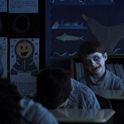Alexander Sokurov's Russian Ark, "the ultimate trip, a post-2001 space odyssey" (photo: Fora Film/Hermitage Bridge Studio/The Kobal Collection)
The movies are dying. Big films are stomping out small. Marketing, not quality, is the only route to box office success. As one observer puts it, “If the advertising for a movie doesn’t build up an overwhelming desire to be part of the event, people just don’t go.”
That observation is correct. But it was written not in 2012, as comic book films like The Avengers and The Dark Knight Rises invade our screens, but in 1974, by the critic Pauline Kael in an essay with the brazenly optimistic title, “The Future of Movies.” Two decades later, in the mid-1990s, Susan Sontag weighed in with a more dismal diagnosis of the state of cinema. Movies had come to exist, said Sontag, chiefly as commodities that could be shrunk to fit inside our homes, as opposed to larger-than-life dreamscapes projected on a screen.
Any book about cinema’s past is a book about an artform that has, against the odds, been advancing into the future for quite a while now. That’s certainly true of both The Big Screen and Film After Film. The first, by critic and film historian David Thomson, is a chronicle of movies and movie culture since the beginning—“The Story of the Movies and What They Did to Us,” as its subtitle boldly declares. The second book is a collection of essays written by the former Village Voice film critic J Hoberman during the past decade, a personal overview of the first 10 years of 21st century cinema. Both books offer hints of what the future might hold for movies and the view isn’t always pretty.
The good news is that you’ll probably have time to read all 600 pages of The Big Screen before cinema actually dies. Thomson has written nearly 20 books on movies and the motion picture business; the most famous among them is probably A Biographical History of Film. In his prologue to The Big Screen he promises more than just “Méliès to Melancholia”; he’s going for the whole shebang, from “Muybridge to Facebook.”
Thomson’s book isn’t strictly about the movies. It’s about the way we have welcomed screens of all sorts into our lives since the 19th century, for better or worse. He observes that while at one time screens were “as large as buildings,” now “they may be thumbnail size—yet they are vast in their ubiquity and their constant use.” And for a movie lover, Thomson is strikingly wary of the way screens can hypnotise us into forgetting the world beyond the screen: “They make a taunting offer of reality, but I wonder if that isn’t a way of keeping us out of it.”
Thomson is imaginative and energised when he’s speaking of film’s past, when he’s parsing the distinction between the romantic visions of FW Murnau’s Sunrise and Jean Vigo’s L’Atalante, or weighing the inseparable hubris and genius of Orson Welles, or revelling in the magisterial breadth of Francis Ford Coppola’s first two Godfather movies. But when it comes to the present and future of film—or, more specifically, the present and future of our life with these screens of all sizes—the tone changes. Thomson affects an air of pessimistic jauntiness, like a know-it-all uncle who will never really come out and say, “It’s all over, kids!” even though, if you read between the lines, that’s what he seems to believe.
A recent issue of the New Republic featured dual essays by Thomson and David Denby, a film critic for the New Yorker, both gloomily assessing the current state of cinema and movie-going culture. Thomson’s piece offered more of the cheerful ennui that’s found in his book. After listing recent “humane pictures” that he felt told absorbing stories about human lives—movies like Debra Granik’s Winter’s Bone, Paul Thomas Anderson’s There Will Be Blood and Asghar Farhadi’s A Separation—he continued, “You see how positive I am being, even if sometimes seeing the best new movies, and the old, is a little like eating caviar while watching TV footage of the latest famine in Darfur, Pandora, or wherever.”
By contrast, Denby—who has recently published a book called simply, Do the Movies Have a Future?—is more openly pessimistic. And if his tone also carries more than a whiff of the old man on the porch in his rocking chair, lamenting the greatness of bygone days, his argument at least seems to spring from a genuine sense of frustration and despair. In his New Republic essay, he writes, “I’m made crazy by the way the business structure of movies is now constricting the art of movies. I don’t understand why more people are not made crazy by the same thing.”
Denby notes that in the 1930s, “roughly 80m people went to the movies every week, with weekly attendance peaking at 90m in 1930 and again in the mid-1940s.” Now, he says, “about 30m people go, in a population two and a half times the size of the population of the 1930s.” That means more and more of us are watching movies at home, or on the go, sometimes on screens about the size of a cigarette pack.
Both Denby and Thomson are troubled, with good reason, by this development—the shrinking size of screens seems to encourage the shrinking of our collective imagination. In cities everywhere—certainly in New York, where I live—the subways are increasingly dotted with young men (there are women, too, but not quite so many) who rush to their seats and immediately fix their attention on a smartphone, onto which they’ve downloaded some television show or movie. They may look up, briefly, if a pretty girl happens to be standing nearby. But I’ve also seen these men miss beauties of near-supermodel proportions. How could a screen so small have become so all-consuming?
There is, of course, another side to the tragedy of the shrinking screen, which Thomson and Denby rightly acknowledge. New mediums for film have increased the chances that a director’s work will reach its audience. In places where smaller independent or foreign films are unlikely to play in cinemas, film lovers can now watch almost anything at home, via DVD or the internet. Other types of screens are also energising film culture in the 21st century. There’s a world of readers (and bloggers) online who use social media as a way of connecting through movies. It’s not the same as drifting into a coffee shop with friends, circa 1968, to dissect the latest Godard or Truffaut, but in a world of disconnection, any connection is better than none.
The harder reality, however, is that none of these beneficial developments can keep the movies from dying, in the sense that Denby and Thomson use the word. The only hope is to believe that along with the glacial death of movies as we know them, there will be some sort of gradual rebirth. And most important of all, we need to remember that eulogising the movies is an older person’s—or, rather, an older critic’s—game. It would be truly horrifying if critics in their 20s and 30s, people who are open to watching all kinds of movies—The Avengers, sure, but also pictures made by the likes of Hou Hsaio-hsien and Terrence Malick, filmmakers who work outside big-budget Hollywood—began to write these end-of-an-era laments.
You could argue that film critics don’t matter much, that almost no “real” people read criticism anymore. In the past, 30 or 40 years ago, even casual moviegoers would probably have had some sense of what critics like Rex Reed, Roger Ebert and Pauline Kael were thinking. Even so, the reading and writing of criticism, that specific act of caring very deeply, has always been the province of a strange, relatively small club whose members have always, thankfully, found their way to one another. Any hope the movies have for the future lies in the survival of that compact, passionate band of outsiders. Our cultural memory will survive with them; it will have to.
And that’s where a book like J Hoberman’s Film After Film comes in. Nowhere does Hoberman—who was the senior film critic for the Village Voice from 1988 to 2012—speak overtly about the death of movies, but that doesn’t mean he’s unaware of the hovering spectre. His opening salvo is a brief, methodical treatise tracing influential French film critic André Bazin’s theory of “Total Cinema”—that the savants of the filmworld aim to mimic reality as closely as possible—to its unanticipated outcome: the development of computer-generated imagery (CGI). “Bazin had imagined cinema as the objective ‘recreation of the world,’” Hoberman writes. “Yet digital image-making precludes the necessity of having the world, or even a really existing subject, before the camera—let alone the need for a camera.”
If that’s not a riff on the “end of cinema,” I don’t know what is. Yet Hoberman’s tone is anything but pessimistic. The final third of Film After Film—a collection of Hoberman’s pieces, all written under the typical critic’s weekly deadline pressure—is bracing, as well as quietly hopeful. He calls Alexander Sokurov’s 2002 Russian Ark, a tour through 33 rooms of the Hermitage museum in St Petersburg unfolding in a single 96-minute tracking shot, “the ultimate trip, a post-2001 space odyssey.” He captures the specific sense of loneliness and dislocation, at once modern and timeless, of Taiwanese director Tsai Ming-liang’s 2002 Goodbye, Dragon Inn. He finds the real meat in sprawling, fascinating messes like Richard Kelly’s Southland Tales and David Lynch’s Inland Empire, both from 2006.
The weekly critic—as Hoberman, Denby and Thomson all are—is the guy in the trenches, fielding the hits and misses as they come. It can be exhilarating work, and it can be heartbreaking. But if you do it right, what you’ve come up with, at the end of a year or a decade or a quarter-century of writing regularly, is a diary of the culture, a narrative that tracks the ups and downs of movies against the ever-changing backdrop of the wider world.
Anyone who truly loves movies must also desire to see the ways in which they change along with the world, and the ways they themselves change the world. That’s a frightening proposition; we’re not always going to like what we see. But if cinema is to survive, we have to keep watching.












